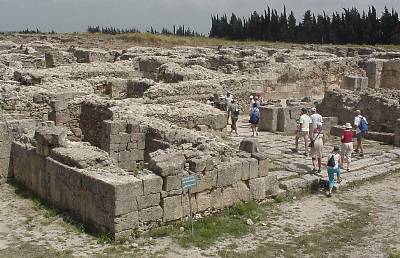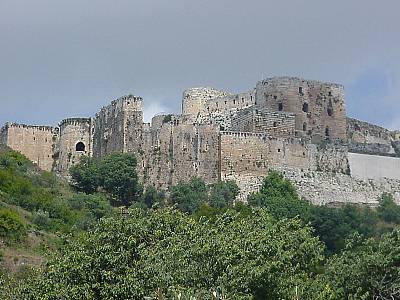 |
 |
 |

 |
Ugarit was an important Mediterranean city in the sixteenth to the twelfth centuries BC, with its peak from about 1450 to 1200. What is special about Ugarit is the discovery of about twenty thousand clay tablets imprinted in cuneiform, stored in its five archives. These tablets contain the very first alphabet, that is, symbols that stand for sounds (as opposed to pictures that stand for concepts.) Twenty-seven consonants and three vowels make up the alphabet. Ugarit is the base for Arabic and Aramaic, and the letters are the source of the alphabets for the Greek, Etruscan and Latin languages. |
| Palmyra attained prominence in the third century BC, when
the road through it became part of the trade route, and it was an important
Greek/Roman city in the second century AD. Queen Zenobia, married to
Odenathus, claimed to have been descended from Cleopatra. When her husband
and his son from a previous marriage were murdered, probably by the Romans,
the locals suspected foul play by Zenobia. The legend was fed when she took
over the leadership (and did a fine job for some time, actually, before her
defeat by Aurelian a few years later.)
The Temple of Bel, at right, was constructed in 16-17 AD and honors the most important god in the Babylonian pantheon. |
 |
|
|
Though it isn't the largest castle in Syria, the Qala'at
Saladin or Castle of Saladin inspired T.E. Lawrence to write, "It was I
think the most sensational thing in castle building I have seen." The castle is protected on three sides by huge cliffs. On the side that had been unprotected by nature, all of the side except a huge monolith was carved out to support the entry bridge, and most of the removed rock was used to build the castle itself. The defenders could remove the four meters of stone blocks that sat atop the monolith and supported the bridge, eliminating all hopes for the attackers to enter. |
|
It's hard to convey the grandeur of the Krak des Chevaliers, which probably looks much as it did 800 years ago. Though the original fortification was probably as far back as the eleventh century, the Crusaders (Chevaliers, or horsemen) created the massive fortification that exists today. In fact, the castle has never been breached. The outside wall of the castle holds thirteen towers and a main entrance, and there is also an inside wall for fortification. The fortress had the capacity to house two thousand soldiers and to withstand a five-year siege. |
 |